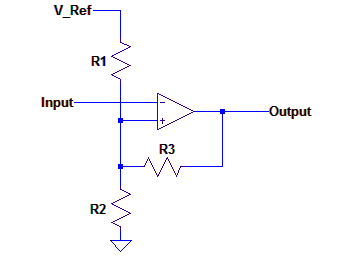Inverting Schmitt Trigger Theory
Electronics Home
Calculator Index
About Us
Privacy Policy

First calculate the voltage at the non-inverting input, \(V_+\) using Ohm's law, \(V=IR\).
The voltage at the non-inverting input will be \(R_2 \times I_2\) where \(I_2\) is the current flowing through \(R_2 \)
If the current flowing into the non-inverting input is negligible, then:
Using (ii) to emliminate \(I_2\) from (i): we get
Since the voltage across \(R_1\) is \(V_{ref} - V_+\), the current flowing through \(R_1\) will be:
Similarly, the current through \(R_3\) will be:
Using (iv) & (v) to eliminate \(I_1\) and \(I_3\) from (iii) gives:
The output will change state when the voltage at the inverting input crosses the voltage at the non-inverting input. The voltage at the non-inverting input is therefore the threshold voltage, \(V_T\):
This looks like an equation with three unknowns. However, we are interested in the ratios of the resistor values rather than the values themselves so we really only have two unknowns.
Make the substitution \( \alpha = \dfrac{R_2}{R_1}\) and \(\beta =\dfrac{R_2}{R_3}\) to get:
Now re-arrange to make \(\alpha\) the subject:
Now consider the case where the output is high, \(V_{out} = V_{OH} \), and the threshold, \( V_{T} = V_{HT} \):
Similarly, when the output is low, \(V_{out} = V_{OL} \), and the threshold, \( V_{T} = V_{LT} \):
Combine equations (viii) & (ix) to eliminate \(\alpha\):
Solve for \( \beta \):
Eventually we get an equation for \( \beta \):
We can now put the numbers in and get a numerical value for \( \beta \). This value can then be used in (ix) to find \(\alpha\).
Now choose a value for R2, say 10kΩ, and solve for R1 & R3 using:
If you don't fancy doing the math yourself you can use my Inverting Schmitt Trigger Calculator.
Inverting Schmitt Trigger Calculator
Non-Inverting Schmitt Trigger Calculator
Click here to report an error on this page.
This page was last changed on: 02 August 2021.
Thanks for visiting my site.